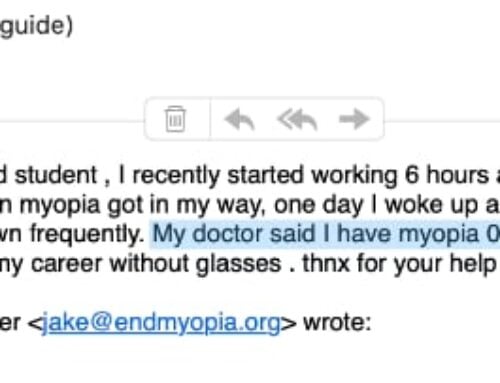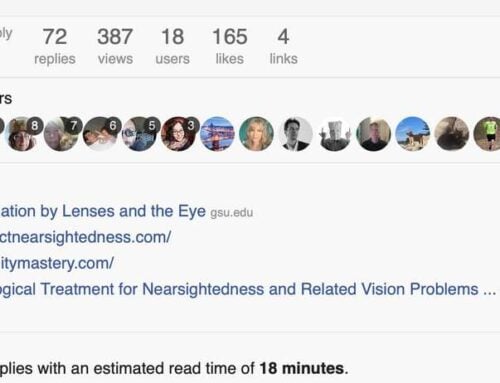For today’s post, an excerpt of the Adult Myopia Rehab Program – Installment #57.
It discusses the finer points of how much you can and should reduce your myopia prescription, as your eyesight continues to improve. The excerpt here skips the actual recommendations, as they are based on previous installments, prescriptions strengths, and a number of fundamental concepts previously discussed in the program.
That’s to say, I’m not withholding just to tease, but because the recommendations would be out of context.
Let’s, then, take a look at relevant parts of this installment:
The higher you go in correction, the more likely it is that there is some axial growth in the eyeball (the eye grew longer to permanently move focus, in response to close-up strain). The more axial growth happens, the more the eyeball is likely to be deformed (cylinder), causing vision to be sharp in some parts of the eye more than others.
The higher the myopia, the more likely some degree of astigmatism correction is warranted. Reducing the astigmatism correction becomes a question of priority – do we first want to have optimum expediency in reducing myopia, or do we want to reduce astigmatism as much as we can?
We must generalize a bit here, since the Web program can not properly account for each individual case. I start with these generalizations when evaluating clients, then adjusting to their case – so while general, this premise is relevant for you as well:
The Relative Correlation of Astigmatism
If you have a -2.5D myopia prescription and your astigmatism correction is -1D, we can assume with some degree of certainty that the prescription does not address physiological realities (ie. your eye probably not actually deformed to warrant a -1D astigmatism prescription).
Your astigmatism correction should be less than 20% of your myopia degree.
There are exceptions, for a whole number of reasons. Still, in most normal cases, 20% is on the high side of reasonable. 10% to 15%, for myopia degrees past -3D might be explicable. More, is less likely.
Consider too, why we want to reduce astigmatism – to reduce prescription complexity. We want a less complex prescription, to closer align your natural eyesight (uncorrected) to your current, corrected eyesight. When you take off your glasses, we are doing much better if it is just a simple focal plane correction change that your brain has to process. If the change also involves cylinder, axis (degree and location of astigmatism correction), and variance (difference between left and right eye), there is a huge amount of change between glasses and no-glasses. The less this change is, the easier it is, psychologically, to adjust to the various focal-plane states (normalized prescription, differential prescription, no prescription).
On the other hand, if your eye is deformed and requires some astigmatism correction, and we forego it, your vision is always compromised. This of course is also not beneficial, since the focusing error makes it more difficult for you to work on focus pulling (at a distance), and getting the healthy baseline of ‘this is what your vision should be’.
So there is the compromise. We don’t want to make your every-day vision unnecessarily handicapped, and at the same time we don’t want an overly complex prescription to deal with.
[…]Make sense? Prescription complexity, astigmatism, slowly and deliberately pulling you out of the maze of dependency that the ever increasing prescriptions have landed you in.
It is all quite manageable once you break it down into it’s individual components.
Always think of this process as unwinding the clock. We are not doing a whole lot more than playing the tape in reverse, reducing what was increased before, while also managing what caused this particular myopia movie in the first place – all that unchecked close-up eye strain.
Enjoy!




















